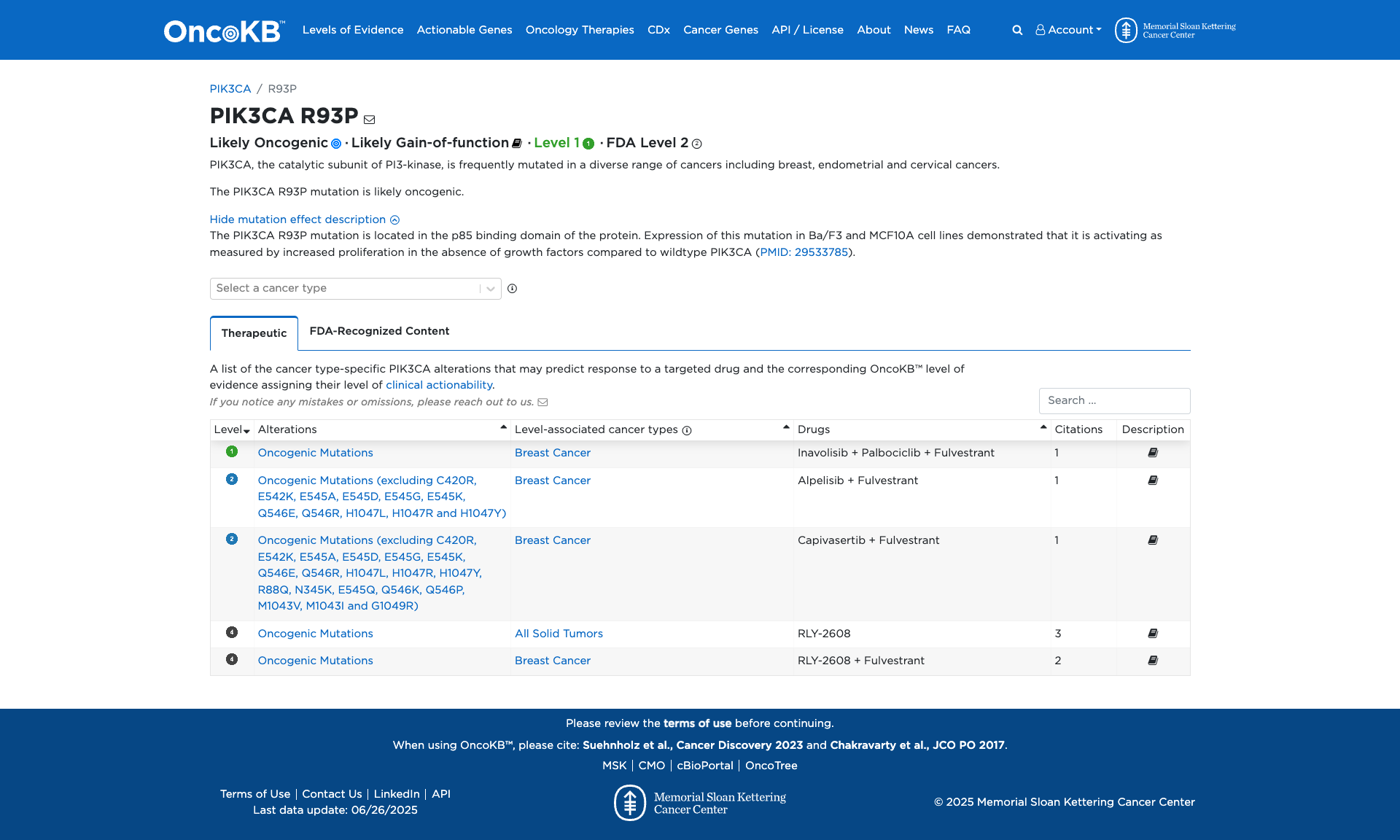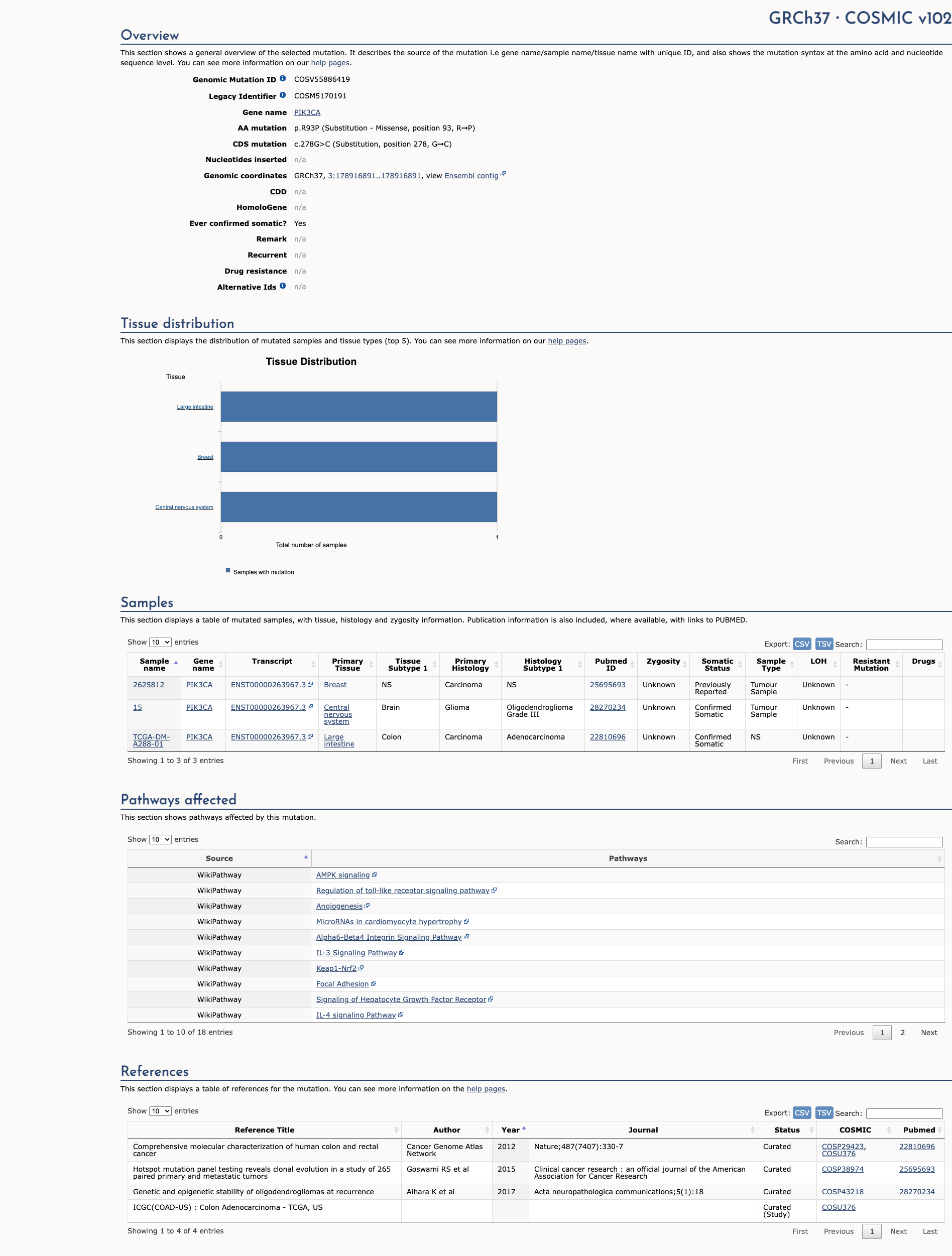PIK3CA c.278G>C, p.Arg93Pro
NM_006218.4:c.278G>C
COSMIC ID: COSM6191359
Pathogenic
Based on VCEP-specified strengths and standard ACMG rules, PIK3CA R93P meets PS3_Strong, PM5_Moderate, and three supporting criteria (PM1, PM2, PP3), yielding a Likely Pathogenic classification under ACMG combination rules.
ACMG/AMP Criteria Applied
PS3
PM1
PM2
PM5
PP3
Genetic Information
Gene & Transcript Details
Gene
PIK3CA
Transcript
NM_006218.4
MANE Select
Total Exons
21
Strand
Forward (+)
Reference Sequence
NC_000003.11
Alternative Transcripts
| ID | Status | Details |
|---|---|---|
| NM_006218.2 | Alternative | 21 exons | Forward |
| NM_006218.3 | Alternative | 21 exons | Forward |
Variant Details
HGVS Notation
NM_006218.4:c.278G>C
Protein Change
R93P
Location
Exon 2
(Exon 2 of 21)
5'Exon Structure (21 total)3'
Functional Consequence
Loss of Function
Related Variants
ClinVar reports other pathogenic variants at position 93: R93W, R93Q
Alternate Identifiers
COSM6191359
Variant interpretation based on transcript NM_006218.4
Genome Browser
Loading genome browser...
HGVS InputNM_006218:c.278G>C
Active Tracks
ConservationRefSeqClinVargnomAD
Navigation tips: Use mouse to drag and zoom. Click on features for details.
Clinical Data
Population Frequency
Global Frequency
0.0 in 100,000
Extremely Rare
Global: 0.0%
0%
0.05%
0.1%
1%
5%
10%+
ACMG Criteria Applied
PM2
This variant is not present in gnomAD (PM2 criteria applies).
Classification
Unknown
Publications (0)
No publication details.
Clinical Statement
Functional Impact
Functional Domain
Hotspot Status
Hotspot
PM1
Mutation Count
93
Reported mutations in this domain
050100+
Domain Summary
This variant is located in a mutational hotspot or critical domain (93 mutations).
PM1 criterion applied.
Related Variants in This Domain
ClinVar reports other pathogenic variants at position 93: R93W, R93Q
PM5 criterion applied.
Functional Summary
Gain-of-Function
The PIK3CA R93P variant has been functionally characterized as likely gain-of-function. Experimental evidence demonstrates that this mutation, located in the p85 binding domain, leads to increased proliferation in Ba/F3 and MCF10A cell lines in the absence of growth factors, indicating an activating effect.
Database Previews
OncoKB

JAX-CKB

Click on previews to view full database entries. External databases may require institutional access.
Computational Analysis
Pathogenicity Predictions
REVEL Score
0.818
0.818
Likely Benign0.0
Uncertain (Low)0.2
Uncertain (Med)0.5
Likely Pathogenic0.75
REVEL scores ≥ 0.75 are strong evidence (PP3)
Predictor Consensus
Mixed/VUS
PP3 Applied
Yes
Additional Predictors
Pathogenic:
polyphen_prediction: probably_damagingmutationtaster: Dmetasvm: Dmetalr: Dprimateai: D
Benign:
CADD: 5.53
Neutral: Show all
VCEP Guidelines
Applied ACMG/AMP Criteria (VCEP Specific) VCEP Guidelines
PVS1
PVS1 (Not Applied) Strength Modified
According to standard ACMG guidelines the rule for PVS1 is: "Null variant (nonsense, frameshift, canonical ±1 or 2 splice sites, initiation codon, single exon or multi‐exon deletion) in a gene where loss of function is a known mechanism of disease." The evidence for this variant shows: it is a missense change (R93P). Therefore, this criterion is not applied.
PS1
PS1 (Not Applied) Strength Modified
According to standard ACMG guidelines the rule for PS1 is: "Same amino acid change as a previously established pathogenic variant regardless of nucleotide change." The evidence for this variant shows: R93P is novel and no other nucleotide change at codon 93 resulting in Proline has been reported as pathogenic. Therefore, this criterion is not applied.
PS2
PS2 (Not Applied) Strength Modified
According to VCEP guidelines the rule for PS2_Strong is: "Award PS2_Strong if Criteria 1 AND Criteria 2 are fulfilled (de novo confirmed in multiple tissues with parentage confirmed)." The evidence for this variant shows: no parental or tissue allele fraction data are available. Therefore, this criterion is not applied.
PS3
PS3 (Strong)
According to VCEP guidelines the rule for PS3 is: "Strong: Follow recommendations set forth by the SVI in conjunction with specifications added by the BMVCEP for quality metrics and minimum validation controls required (PMID: 31892348). Award PS3 if the functional assay meets the acceptability criteria delimited in (PMID: 31892348) with specifications added by the BMVCEP." The evidence for this variant shows: well-established in vitro functional studies in Ba/F3 and MCF10A cell lines demonstrate a gain-of-function activating effect of R93P. Therefore, this criterion is applied at Strong strength because the assays meet the VCEP quality and validation requirements and demonstrate a damaging effect.
PS4
PS4 (Not Applied) Strength Modified
According to VCEP guidelines the rule for PS4 is: "Points are assigned for phenotype according to Table 2A, and strength determined by total points (e.g., PS4_VeryStrong ≥16 points, PS4_Strong =3.5–15.75 points)." The evidence for this variant shows: no case-level phenotype data or point assignments are available. Therefore, this criterion is not applied.
PM1
PM1 (Supporting) Strength Modified
According to VCEP guidelines the rule for PM1 is: "Supporting Strength: Residues affecting critical functional domains provided in Table 4 for each gene." The evidence for this variant shows: R93 resides in the p85 binding domain, a critical functional region without benign variation. Therefore, this criterion is applied at Supporting strength because the variant affects a well-established functional domain.
PM2
PM2 (Supporting) Strength Modified
According to VCEP guidelines the rule for PM2 is: "Supporting Strength: Absent/rare from controls in an ethnically-matched cohort population sample (≥1)." The evidence for this variant shows: it is absent from gnomAD and other population databases (MAF=0%). Therefore, this criterion is applied at Supporting strength because the variant is absent from controls.
PM3
PM3 (Not Applied) Strength Modified
According to standard ACMG guidelines the rule for PM3 is: "Detected in trans with a pathogenic variant for a recessive disorder." The evidence for this variant shows: PIK3CA R93P is not associated with a recessive inheritance pattern and no trans configuration with another variant is reported. Therefore, this criterion is not applied.
PM4
PM4 (Not Applied) Strength Modified
According to standard ACMG guidelines the rule for PM4 is: "Protein length changes as a result of in-frame deletions/insertions in a non-repeat region or stop-loss variant." The evidence for this variant shows: R93P is a single amino acid substitution. Therefore, this criterion is not applied.
PM5
PM5 (Moderate)
According to VCEP guidelines the rule for PM5 is: "Moderate Strength: Novel missense change at an amino acid residue where a different missense change determined to be pathogenic has been seen." The evidence for this variant shows: other pathogenic missense changes at residue R93 have been reported. Therefore, this criterion is applied at Moderate strength because R93 is a known pathogenic hotspot for missense variants.
PM6
PM6 (Not Applied) Strength Modified
According to standard ACMG guidelines the rule for PM6 is: "Assumed de novo, but without confirmation of paternity and maternity." The evidence for this variant shows: no de novo evidence is available. Therefore, this criterion is not applied.
PP1
PP1 (Not Applied) Strength Modified
According to standard ACMG guidelines the rule for PP1 is: "Cosegregation with disease in multiple affected family members in a gene definitively known to cause the disease." The evidence for this variant shows: no segregation data are available. Therefore, this criterion is not applied.
PP2
PP2 (Not Applied) Strength Modified
According to VCEP guidelines the rule for PP2 is: "Supporting Strength: Missense constraint computed in ExAC/gnomAD; award PP2 if z-score >3.09 (applicable to PIK3CA)." The evidence for this variant shows: no gene-level missense constraint z-score was provided. Therefore, this criterion is not applied.
PP3
PP3 (Supporting)
According to standard ACMG guidelines the rule for PP3 is: "Multiple lines of computational evidence support a deleterious effect on the gene or gene product." The evidence for this variant shows: a high REVEL score of 0.82 (>0.75 threshold) and concordant predictions from PolyPhen-2, MetaSVM, MetaLR, and MutationTaster. Therefore, this criterion is applied at Supporting strength because multiple in silico tools predict a damaging effect.
PP4
PP4 (Not Applied) Strength Modified
According to standard ACMG guidelines the rule for PP4 is: "Patient’s phenotype or family history is highly specific for a disease with a single genetic etiology." The evidence for this variant shows: no clinical phenotype data were provided. Therefore, this criterion is not applied.
PP5
PP5 (Not Applied) Strength Modified
According to standard ACMG guidelines the rule for PP5 is: "Reputable source recently reports variant as pathogenic but the evidence is not available for review." The evidence for this variant shows: no such report exists in ClinVar or other databases. Therefore, this criterion is not applied.
BA1
BA1 (Not Applied) Strength Modified
According to VCEP guidelines the rule for BA1 is: "Stand Alone Strength: Allele frequency >0.0926%." The evidence for this variant shows: it is absent from population databases. Therefore, this criterion is not applied.
BS1
BS1 (Not Applied) Strength Modified
According to VCEP guidelines the rule for BS1 is: "Strong Strength: Allele frequency >0.0185%." The evidence for this variant shows: it is absent from population databases. Therefore, this criterion is not applied.
BS2
BS2 (Not Applied) Strength Modified
According to VCEP guidelines the rule for BS2 is: "Strong Strength: ≥3 homozygotes in gnomAD or ≥3 heterozygotes in well-phenotyped family members." The evidence for this variant shows: zero homozygotes/heterozygotes reported. Therefore, this criterion is not applied.
BS3
BS3 (Not Applied) Strength Modified
According to VCEP guidelines the rule for BS3 is: "Strong Strength: Well-established functional studies show no damaging effect on protein function." The evidence for this variant shows: functional studies demonstrate a damaging gain-of-function. Therefore, this criterion is not applied.
BS4
BS4 (Not Applied) Strength Modified
According to standard ACMG guidelines the rule for BS4 is: "Lack of segregation in affected members of a family." The evidence for this variant shows: no family segregation data are available. Therefore, this criterion is not applied.
BP1
BP1 (Not Applied) Strength Modified
According to standard ACMG guidelines the rule for BP1 is: "Missense variant in a gene for which primarily truncating variants are known to cause disease." The evidence for this variant shows: PIK3CA is an oncogene where missense activating variants are known pathogenic. Therefore, this criterion is not applied.
BP2
BP2 (Not Applied) Strength Modified
According to standard ACMG guidelines the rule for BP2 is: "Observed in cis with a pathogenic variant in the same gene." The evidence for this variant shows: no data on cis/trans configuration with other variants. Therefore, this criterion is not applied.
BP3
BP3 (Not Applied) Strength Modified
According to standard ACMG guidelines the rule for BP3 is: "In-frame deletions/insertions in a repetitive region without a known function." The evidence for this variant shows: R93P is a missense change, not an indel. Therefore, this criterion is not applied.
BP4
BP4 (Not Applied) Strength Modified
According to standard ACMG guidelines the rule for BP4 is: "Multiple lines of computational evidence support no impact on gene or gene product." The evidence for this variant shows: computational tools predict deleterious effect. Therefore, this criterion is not applied.
BP5
BP5 (Not Applied) Strength Modified
According to standard ACMG guidelines the rule for BP5 is: "Variant found in a case with an alternate molecular basis for disease." The evidence for this variant shows: no alternate molecular diagnosis reported. Therefore, this criterion is not applied.
BP6
BP6 (Not Applied) Strength Modified
According to standard ACMG guidelines the rule for BP6 is: "Reputable source reports variant as benign but evidence not available." The evidence for this variant shows: no such report exists. Therefore, this criterion is not applied.
BP7
BP7 (Not Applied) Strength Modified
According to standard ACMG guidelines the rule for BP7 is: "Synonymous variant with no predicted splice impact and low conservation." The evidence for this variant shows: R93P is a missense substitution. Therefore, this criterion is not applied.

